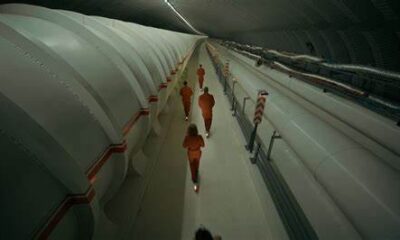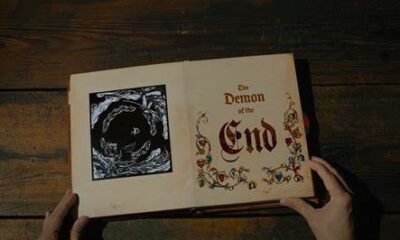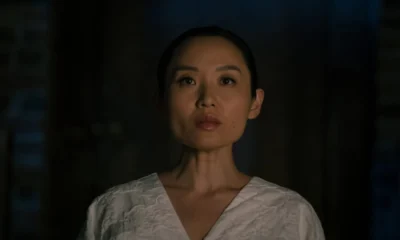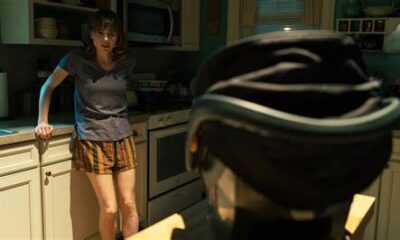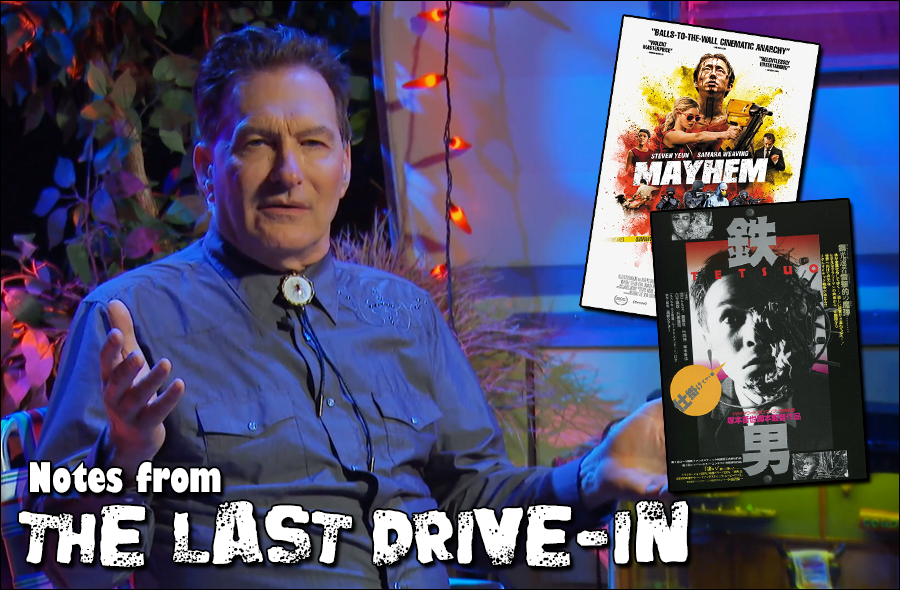
Notes from The Last Drive-In: S2E7
Haha, what the Hell, folks. What just happened? Please let us know you’re okay and not turning into sentient industrial junkyard.
Oh, and welcome to Notes from The Last Drive-In.
Mayhem (2017)
Opening Rant: Evading taxes with creative accounting.
Tonight was not my first experience with Joe Lynch’s Mayhem. One of my first reviews on the site way back last year was for the Shudder exclusive, a review, coincidentally, written on my birthday. I was particularly effusive with my praise of the film, and I had maybe seen it one other time since. Does it still hold up?
Hell yes it does.
Mayhem is a very fun, energetic film with a simple plot but is still incredibly satisfying. The pairing of Steven Yeun and Samara Weaving is one I am eager to see again and it’d be great if they were reunited with Joe Lynch, who has a fun little cameo as an IT guy. It’s not a deep film, and it is not my favorite “tower” film out there, but it is one that I can probably watch at least a couple of times a month. It just clicks. It has a great score, it has some fun fights, just enough gore, and just about every character delivers something cool, shocking, or repulsively capitalistic.
Joe Bob’s assessment was fair. He gave the film three stars and his criticisms, the legitimate ones at least, make sense. As bold and assertive as the film is at times, it also feels equally reticent to really dig into violence. Sure, there is on-camera sex (apparently the Serbian extras just went for it, hard) and plenty of blood, but the lack of kill shots for major characters feels lacking. It is sometimes said that the mind makes horrors greater than any filmed moment, but that doesn’t really seem to be the case here. Significant deaths seem to happen off-screen and any violence displayed stops just short of the actual moment of death.
It’s a strange thing to talk about, particularly given what is going on in the world (talk about a timely movie for this season, too). A film like Mayhem is in many ways a form of catharsis. It is violent, stylish, and scratches an itch for a desire to just wreck stuff, but the reluctance to go further feels like a misstep.
Most of the criticism lobbed at the film was tongue-in-cheek. Joe Lynch is a big fan of The Last Drive-In and often live-tweets his reaction to the episodes. The back and forth between the screen and twitter accounts was truly hilarious and the show could benefit from having him on as a guest in the future.
As for my own assessment, I still very much enjoy Mayhem and it’s worth many, many re-watches. Sure, I wish it were a little bloodthirstier, but I cannot fault the film too greatly for it. After all, though it was filmed in Serbia we certainly don’t need another Serbian Film. Mayhem is a four and a half Cthulhu film.
 (4.5 / 5)
(4.5 / 5)
Best Line: “No, Derek. This – this – this meditation & this incense, it’s all bullshit. You think I like the taste of kale? Come on! I’m fucking dead inside.” – Ewan

Testuo: The Iron Man (1989)
Opening Rant: Cyberpunk and whatever the hell Tetsuo is.
What the actual Hell? If The Last Drive-In wanted to open Pride month with a weird, oddball film, well, they absolutely nailed it. And then shoved those nails deep into the thighs of viewers all over the internet.
Tetsuo: The Iron Man might be the cultiest of the cult films that has ever aired on the show. Shin’ya Tsukamoto’s film, at least the aired cut, is just over an hour in length but may still be a bit much for the average viewer. The best way to describe the film is that it is like cyberpunk exploration of sexuality, technology, and the guilt/pain of coming out, particularly when the coming out is motivated by trauma. I think I have a handle on the film, but I can’t really be sure. I don’t know if I can be sure of anything anymore.
I hesitate to call it a “film” in the sense that we are used to as viewers of The Last Drive-In. That is not an indictment of the quality, Testuo is well shot, edited, and is absolutely striking, but more an observation that the material skews a bit too arthouse in my opinion. It’s like an extended art project. Yes, a narrative is there, a character grows, and you get some sense of closure, but so much of what surrounds that seems to be experiments in visual and audio to the detriment of compelling storytelling.
I am glad to have finally really watched Tetsuo beyond clips at goth clubs but I don’t know if I really feel it is something I feel compelled to explore further unless I am perhaps under some form of chemical stimulation.
Joe Bob’s assessment of the film is particularly hilarious. You can tell he admires the artistry that had gone into it, and his own knowledge of the punk scene of the 1980s endears him to me even further. But perhaps the oddity of Testuo is best summarized at the moment where Joe Bob Briggs waffles between one star and four stars several times, essentially hedging his bets and telling his audience that even he knows that this is a weird one.
It was a weird, hilarious watch with the MutantFam and even resulted in a guest appearance from mangled-dick expert Felissa Rose. The Last Drive-In has had a few oddball films during its run. It just seems very striking they all seem to come from Japan.
While I can’t say that I am in love with Tetsuo: The Iron Man, I can say I am glad I experienced it. I may even experience it again sometime, but I’ll probably be on something when I do. Given that, I don’t think I can go higher than two Cthulhus for the film, a cyberpunk-pillar that it may be.
 (2 / 5)
(2 / 5)
Best Line: “Together, we can turn this fucking world to rust!” – Metal Fetishist

Haunted MTL Drive-In Totals
As per usual, the Drive-In totals for a Japanese film are suitably bonkers. But extra credit to Mayhem for “Dead Body Pissing.”
What about our totals? A little lacking this week, admittedly. I was too taken in by the madness that was Tetsuo: The Iron Man.
- 1 Darcy Jailing
- 2 Level Cards
- 2 Very Enthused Extras
- Elevator Antics
- Basement Bash
- 2×4 Fu
- Yuki Fu
- Tunnel Running Fu
- Black and White Fu
- Director Cameo Fu
- Drilldo Fu
- Exploding Acne
- Office Aardvarking
- Mouth Macing
- Cocaine-Fueled Club Swinging
- Joe Bob Stumping
- Director Insulting
- Divorced Barbie Joking
- Alaskan Whorehouse Joking
- Gratuitous Ernie Parody
- Gratuitous Flashback
- Darcy Cosplay: Melanie
- Silver Bolo Winner: Witch Finger Podcast

Episode Score
A general crowd favorite film paired with such an oddball Japanese choice is probably going to be a bit divisive overall. It also was the shortest episode of The Last Drive-In yet, but that’s not necessarily a bad thing. Testuo was rough.
 (4 / 5)
(4 / 5)
Please join us next time when we live-tweet The Last Drive-In. It’s always a blast and we’ve had more of our writers pop in with each episode so you don’t have to put up with me alone.
Movies n TV
Wheel of Time A Question of Crimson Is a Political Espionage Delight
Episode two of Wheel of Time felt like the beginning of a long journey. Stories are unfolding, lives are changing, and blood is spilling.
Let’s discuss.
The story
We begin this episode in the past with Elayne’s mother, Queen Morgase. It turns out her rise to the throne was a bit, shall we say, cutthroat. So when she shows up at the White Tower, Siuan is concerned.
She might have reason to be, too.
Meanwhile, Rand, Egwene, Moiraine, Lan and Aviendha are in the Spine of The World. As they travel through some of the most breathtaking lands I have ever seen on a TV show, Egwene is plagued with nightmares. We think at first that’s just her trauma working itself through her system. But we soon find out that it might not be that straightforward.
Finally, Perrin returns home to heal after his hand is almost cut in half. But when he gets there he finds the town has been infested by Children of The Light. And they’re looking for him.
What worked
There was something heartwarming in this episode about political espionage and choking religious persecution. And that is Elayne’s relationship with her family.
I have consumed a lot of fantasy content with royal families. And I have never once heard a princess call her mother ‘Mum’. I’ve never seen royal siblings get along. And I have sure as hell never seen a princess have a good relationship with her step-parent.
This was refreshing. Even though Queen Morgase is kind of a horrible person she seems like a good mother. And that’s an unexpected delight.

Of course, this is just one storyline among many. And while this can sometimes be overwhelming, in this case it wasn’t.
I’ll be honest, some of these storylines are going to drag for me. I know this because I’ve read some of the Wheel of Time books and I have an idea that not all the characters exactly pique my interest.
No one likes all the characters. No one likes all the storylines. While I am here for the political espionage between Queen Morgase and Siuan, not everyone likes it. While others might be fascinated with Selene trying to win Rand back, I couldn’t care less.
Having multiple storylines keeps everyone’s attention better. So long as things don’t get out of hand. Things can easily get out of hand. But this seems to be managed well.
So far.
What didn’t work
As I mentioned above, I’m not thrilled with Rand’s story at this point. And while it’s fine to not like a storyline when there are this many to choose from, it’s not fantastic that the one I like the least is the one involving our two main characters. And anytime we were with the team at the Spine of The World, the only thing that brought me joy was Moirain’s hat. It reminded me of Stockard Channing’s hat in Practical Magic.
The problem is that Rand is Charlie Brown with controversial magical powers. He is boring, serious, and pessimistic.
And yes, I understand that he has a heavy emotional burden and he’s the Dragon Reborn and that’s quite taxing and all. But let’s be fair, there isn’t a single person in this show that doesn’t have a heavy burden. And most of them manage to be fun occasionally.

All that being said, this episode of Wheel of Time did exactly what it needed to do. It set up conflicts at each of the three locations. It established emotional ties between the characters and the events. And it established goals for everyone.
This was, in short, a solid episode. Not groundbreaking, not mind-blowing or life changing. It was simply good. It was entertaining and moved the plot forward.
Well done.
 (3.5 / 5)
(3.5 / 5)
Movies n TV
Wheel of Time Returns With A Bang
Wheel of Time is back for season three. There are mixed feelings regarding this. Last season, there were some serious pacing issues. And some serious sticking to the book’s storyline issues. But we’re two seasons in, and we don’t give up so easily. So let’s dive into episode one, To Race the Shadow.
By the way, I highly recommend watching this episode with the subtitles on. You’ll see why.
The story
We begin this episode with Liandrin facing a trial of sorts for her rampant betrayal. She does her best to gaslight her Aes Sedai sisters into thinking that Siuan Sanche is the real traitor.

When that doesn’t work, she reveals how many Black Aes Sedai have actually infiltrated the tower.
Spoiler, it’s a lot.
In the aftermath, our whole team gathers to drink and enjoy one night of relaxation before they head out to the Tear to form an army for Rand. All is going well until they’re attacked by myriad creatures and a sentient axe.
What worked
This episode was long. It had a run time of an hour and eleven minutes. And a lot of that run time was spent in heavy dialog scenes.
Fortunately, these were well-done scenes.
If you’re going to have a lot of talking scenes, there are good ways and bad ways to do it. Last season, we saw lots of examples of the bad way to do it. But this episode did it well. For one thing, other things were going on while conversations were taking place. The characters are drinking, playing games, walking through an interesting city. And the scenes themselves didn’t stretch out. They weren’t repetitive. We heard what the character had to say, then we moved on.
It was also nice that the point of these scenes wasn’t just info dumps. We had character development. We had romantic interactions. We had plot development and foreshadowing.
Overall, this episode felt like what it was. A moment of calm before a storm.
Taking a step back, I’d be remiss if I didn’t address the fight scene at the start of the episode. Because it was epic.
The magic looked amazing. The martial arts that went along with it looked fantastic. The costumes were beautiful. It was just incredibly fun to watch.
More than that, it was emotional. We lost some characters in that fight that were important. And it was clearly emotionally shattering for many of our characters, who found themselves betrayed by people they trusted.
So many of them.
It was a great way to open the season.
What didn’t work
Despite that, this episode wasn’t without its flaws.
First off, there were a lot of dialog scenes. And they were good scenes, as I’ve already discussed. But it was one after another after another. And when your episode is, again, an hour and eleven minutes, it’s maybe a little much to have so much chit-chat. Couldn’t some of these conversations, important as they were, have been moved to maybe another episode?
Finally, I want to talk about Egwene’s travel through the arches.

I feel like maybe there were some deleted scenes here. Because there must have been more to that visit than what we saw, right?
We could have seen Egwene battle Rand. That would have been badass and emotionally devastating. We could have seen her with a quiet life with Rand back home at the Two Rivers. We could have seen anything except for the quick clip of Rand in a bloody river, followed by Egwene being shoved back out in a bloody shift.
No products found.
Bad job. But at least it wasn’t an extended scene of Moiraine collecting bathwater, and then taking a bath while looking sad. If we’d started this season with another scene like that, it might have broken my brain.
Amazon dropped the first three episodes at once. So we’ll be back soon to talk about episode two. See you then.
 (4 / 5)
(4 / 5)
Movies n TV
Entertaining as hell: Eight Legged Freaks (2002) Review
Early 2000s is a special era for the industry. It accepts the cheesiness and corniness of movie making, in turn producing some gems in their own right. Eight Legged Freaks starring David Arquette and young Scarlet Johanson is a horror comedy about giant spiders who overtake a small town. As crazy as that premise sounds, the movie surprisingly has a ton of heart and is super entertaining. Let’s review, shall we?
Plot
We start Eight Legged Freaks with a shot of toxic waste spilling into the water supply of Joshua, a spider farm owner. He is friends with Mike, one of our protagonists, who is a science geek and a spider enthusiast. Mike notices something quite right upon visiting Joshua, but no one takes him seriously. We are then introduced to the rest of the crew. Mike’s mother Samantha, the town sheriff, is too busy chasing Ashley, his sister, who is dating the town mayor’s son Bret (something Samantha does not approve of). We also have Chris, who returns to the town to save his father’s legacy in the town mines. He has opposition from Wade, Bret’s father, who wants to use the mines for his business ventures. Lots of drama going on that will only get juicier once the spiders get loose.
The creepy crawlies quickly dispose of Joshua and make their grand appearance after Ashley rejects Bret’s advances, abandoning him in the middle of a desert. A glorious chase sequence ensues as the spiders make their way towards the town, wreaking havoc on its residents. In a true horror fashion (which the movie acknowledges), it takes some convincing from Mike and then from Samantha for the town to take the threat seriously. The tongue-in-cheek style of narrative adds the comedy aspect to a movie that would otherwise burn out fairly quickly.
The remaining characters hide out in a shopping mall as it’s the only somewhat sturdy building in the area. This doesn’t last long as the spiders break in, forcing them to run through the mines. Their resources to fight the creepy crawlies off are limited as the methane gas doesn’t allow them to use firearms. Such conditions require resourceful thinking from Chris, who uses perfume to fend off the leader of the spider group and save himself during the climax of the movie.
Character dynamics are not forgotten once the action kicks in. We have Chris confessing his long-term feelings for Samantha which she knew all along, which provided some comedic relief. Bret also reunites with Ashley and apologises for being an asshole. Mike finally gets the appreciation he deserves as his knowledge saves the townsfolk more than once during the whole ordeal.
We end the movie with the town’s radio show person telling the story as an urban legend during his segment. This brings it into question – how much of it happened the way he said it did? We can only guess…
Overall thoughts
Eight Legged Freaks is a fun creature feature with some self-aware commentary on genre tropes that doesn’t take itself too seriously. The acting is good, the pacing fitting and the characters are likeable enough for you to want them to make it through. Definitely a must watch, if you don’t suffer from arachnophobia, that is.
 (5 / 5)
(5 / 5)
- What do you get when you cross toxic waste with a bunch of exotic spiders? Eaten! The townies of Prosperity, Arizona will all become a screaming smorgasbord if mutated arachnids as big as SUVs have their way in this comedy/horror crowd pleaser whose creators include the producers of Independence Day and Godzilla
- Spiders that leap like gazelles, web-spitting spiders, spiders that suck your insides out as if through a straw—they’re all among the behemoths conjured up by an inventive effects team
- David Arquette (Scream) leads the two-legged stars, mobilizing the citizenry in a last-ditch fight to survive
Last update on 2025-03-10 / Affiliate links / Images from Amazon Product Advertising API


